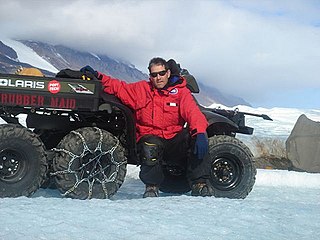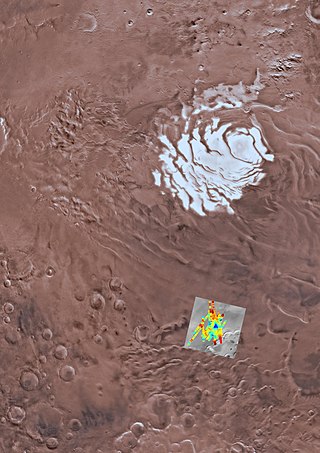
Lake Vostok is the largest of Antarctica's 675 known subglacial lakes. Lake Vostok is located at the southern Pole of Cold, beneath Russia's Vostok Station under the surface of the central East Antarctic Ice Sheet, which is at 3,488 m (11,444 ft) above mean sea level. The surface of this fresh water lake is approximately 4,000 m (13,100 ft) under the surface of the ice, which places it at approximately 500 m (1,600 ft) below sea level.

The McMurdo Dry Valleys are a row of largely snow-free valleys in Antarctica, located within Victoria Land west of McMurdo Sound. The Dry Valleys experience extremely low humidity and surrounding mountains prevent the flow of ice from nearby glaciers. The rocks here are granites and gneisses, and glacial tills dot this bedrock landscape, with loose gravel covering the ground. It is one of the driest places on Earth and is sometimes claimed to have not seen rain in nearly two million years, though this is highly unlikely and several anecdotal accounts of rainfall within the Dry Valleys exist.

Lake Fryxell is a frozen lake 4.5 kilometres (2.8 mi) long, between Canada Glacier and Commonwealth Glaciers at the lower end of Taylor Valley in Victoria Land, Antarctica. It was mapped in the early 1900s and named during Operation Deep Freeze in the 1950s. There are several forms of algae living in the waters and a weather station located at the lake.

Polar deserts are the regions of Earth that fall under an ice cap climate. Despite rainfall totals low enough to normally classify as a desert, polar deserts are distinguished from true deserts by low annual temperatures and evapotranspiration. Most polar deserts are covered in ice sheets, ice fields, or ice caps, and they are also called white deserts.

A subglacial lake is a lake that is found under a glacier, typically beneath an ice cap or ice sheet. Subglacial lakes form at the boundary between ice and the underlying bedrock, where gravitational pressure decreases the pressure melting point of ice. Over time, the overlying ice gradually melts at a rate of a few millimeters per year. Meltwater flows from regions of high to low hydraulic pressure under the ice and pools, creating a body of liquid water that can be isolated from the external environment for millions of years.
Whillans Ice Stream is a glaciological feature of the West Antarctic Ice Sheet, formerly known as Ice Stream B, renamed in 2001 in honor of Ohio State University glaciologist Ian Whillans.

John C. Priscu, is a Romanian-American scientist who is the current Professor of Ecology in the Department of Land Resources and Environmental Sciences at Montana State University. He is a principal investigator in the McMurdo Dry Valleys Long Term Ecological Research (LTER) project.

Lake Bonney is a saline lake with permanent ice cover at the western end of Taylor Valley in the McMurdo Dry Valleys of Victoria Land, Antarctica.

Blood Falls is an outflow of an iron oxide–tainted plume of saltwater, flowing from the tongue of Taylor Glacier onto the ice-covered surface of West Lake Bonney in the Taylor Valley of the McMurdo Dry Valleys in Victoria Land, East Antarctica.

Antarctica is one of the most physically and chemically extreme terrestrial environments to be inhabited by lifeforms. The largest plants are mosses, and the largest animals that do not leave the continent are a few species of insects.
There are hundreds of antarctic lakes in Antarctica. In 2018 researchers at the Alfred Wegener Institute for Polar and Marine Research published a study they claimed cast doubt on the earlier estimate that there were almost 400 subglacial antarctic lakes. Antarctica also has some relatively small regions that are clear of ice and snow, and there are some surface lakes in these regions. They called for on the ground seismic studies, or drilling, to determine a more reliable number.

Lake Whillans is a subglacial lake in Antarctica. The lake is located under the Whillans Ice Stream at the southeastern edge of the Ross Ice Shelf in the west of the continent. The lake surface is 800 m (2,600 ft) beneath the surface of the ice and the lake covers an estimated area of 60 km2 (20 sq mi). Lake depths measured thus far have been around 2 metres. Its temperature is −0.49 °C, below 0 °C because of the high pressure.
Helen Amanda Fricker is a glaciologist and professor at Scripps Institution of Oceanography at the University of California, San Diego where she is a director of the Scripps Polar Center. She won the 2010 Martha T. Muse Prize for Science and Policy in Antarctica.

Terry Jean Wilson is an international leader in the study of present-day tectonics in Antarctica. She has led large, international efforts, such as Polar Earth Observing Network (POLENET), to investigate the interactions between the Earth's crust and the cryosphere in Antarctica.

Cristina Takacs-Vesbach is an American microbial ecologist conducting research on the productivity, diversity, and function of microbial communities living at the two extremes of temperature found on Earth-Antarctica's McMurdo Dry Valleys and Yellowstone National Park's thermal springs.

Jill Ann Mikucki is an American microbiologist, educator and Antarctic researcher, best known for her work at Blood Falls demonstrating that microbes can grow below ice in the absence of sunlight. She is a leader of international teams studying study ecosystems under the ice.
Mars habitability analogue environments on Earth are environments that share potentially relevant astrobiological conditions with Mars. These include sites that are analogues of potential subsurface habitats, and deep subsurface habitats.
Mercer Subglacial Lake is a subglacial lake in Antarctica covered by a sheet of ice 1,067 m (3,501 ft) thick; the water below is hydraulically active, with water replacement times on the order of a decade from the Ross Sea. Studies suggest that Mercer Subglacial Lake as well as other subglacial lakes appear to be linked, with drainage events in one reservoir causing filling and follow-on drainage in adjacent lakes.

Lake Washburn is a lake that formerly existed in the Taylor Valley, McMurdo Dry Valleys, Antarctica. It formed when climatic changes and an expansion of ice caused the flooding of the valley, between 23,000 and 8,340 radiocarbon years ago. Its extent and elevation are unclear but Lake Bonney and Lake Fryxell are considered to be its present-day remnant.

Salty subglacial lakes are controversially inferred from radar measurements to exist below the South Polar Layered Deposits (SPLD) in Ultimi Scopuli of Mars' southern ice cap. The idea of subglacial lakes due to basal melting at the polar ice caps on Mars was first hypothesized in the 1980s. For liquid water to persist below the SPLD, researchers propose that perchlorate is dissolved in the water, which lowers the freezing temperature, but other explanations such as saline ice or hydrous minerals have been offered. Challenges for explaining sufficiently warm conditions for liquid water to exist below the southern ice cap include low amounts of geothermal heating from the subsurface and overlying pressure from the ice. As a result, it is disputed whether radar detections of bright reflectors were instead caused by other materials such as saline ice or deposits of minerals such as clays. While lakes with salt concentrations 20 times that of the ocean pose challenges for life, potential subglacial lakes on Mars are of high interest for astrobiology because microbial ecosystems have been found in deep subglacial lakes on Earth, such as in Lake Whillans in Antarctica below 800 m of ice.














